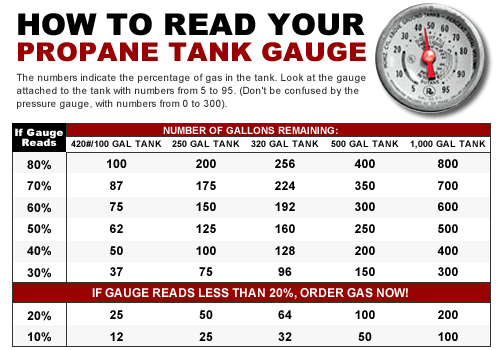Understanding Propane
Reading YOUR GAUGE
Each residential propane tank is fitted with a brass gauge. This gauge is located under the tank’s lid. Lift lid and read the gauge’s arrow. This will determine the percentage of propane in the tank. It will be based on the size of each individual’s tank size.
When the tank read’s 20%, it is time to call the office and schedule a fill.
After Hour Needs
After hour deliveries are available after closing hours until 8:00 p.m. Sunday through Monday, with an additional charge.
If you smell gas
Propane has an additive called, Ethyl Mercaptan, which is a clear liquid that has a distinct odor. This odor is a safety devise to let the user know if there is a leak.
If you smell a scent like rotten eggs, or a skunk’s spray, please call the office and schedule to have your system checked. It could be as simple as needing a refill, but could also mean that there is a leak in the line.
If you smell this scent in your home or office, please leave the area, shut off the gas at the source, and call the office from a neighbor or cell phone. If it is safe to do so, close the valve on your propane tank, turn it to the right.
Appliances
Please call the office when replacing your appliance. All gas appliance must be converted from Natural Gas to Propane. Only a qualified technician can service your appliance.
If you are not sure if your appliances have been converted please call the office to schedule a service call.
Repair
DO not try and modify or repair valves, regulators, connectors, controls, or other appliances and cylinder/tank parts. Doing so creates the risk of gas leaks that can result in property damage, serious injury, or death.
Propane Regulations
Buster Brown Propane follows strict NFPA58, NFPA54, CFR49 regulations, in accordance with the Texas Railroad Commission.
Information provided by 2008 Propane Education & Research Council


